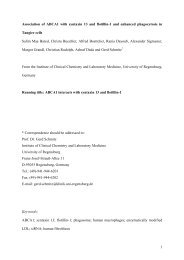SUNDAY, DECEMBER 4- Late Abstracts 1 - Molecular Biology of the ...
SUNDAY, DECEMBER 4- Late Abstracts 1 - Molecular Biology of the ...
SUNDAY, DECEMBER 4- Late Abstracts 1 - Molecular Biology of the ...
You also want an ePaper? Increase the reach of your titles
YUMPU automatically turns print PDFs into web optimized ePapers that Google loves.
<strong>SUNDAY</strong><br />
after <strong>the</strong> membrane adaptor proteins dissociated from <strong>the</strong> patches. We were surprised to find<br />
that actin patches also assembled slowly in <strong>the</strong>se c<strong>of</strong>ilin mutant cells. Adaptor proteins such as<br />
End4p and Pan1p accumulated and persisted at <strong>the</strong> endocytic sites more than 10 times longer<br />
than in wild type cells, followed by delayed put persistent recruitment <strong>of</strong> activators <strong>of</strong> Arp2/3<br />
complex, including WASP and myosin I. We propose that severing by c<strong>of</strong>ilin normally produces<br />
short actin filaments that diffuse out <strong>of</strong> actin patches and stimulate Arp2/3 complex in adjacent<br />
patches by serving as <strong>the</strong> mo<strong>the</strong>r filaments that initiate <strong>the</strong> autocatalytic branching reaction.<br />
Additional feedback mechanisms seem to prolong <strong>the</strong> early steps in <strong>the</strong> pathway until <strong>the</strong> later<br />
steps are executed.<br />
1983<br />
Structural and functional characterization <strong>of</strong> cargo-binding sites <strong>of</strong> <strong>the</strong> µ4-subunit <strong>of</strong><br />
adaptor protein complex 4.<br />
B. H. Ross 1 , E. A. Corales 1 , Y. Lin 1 , J. H. Hurley 2 , J. S. Bonifacino 3 , P. V. Burgos 1 , G. A.<br />
Mardones 1 ; 1 Universidad Austral de Chile Sch Med, Valdivia, Chile, 2 LMB, National Institute <strong>of</strong><br />
Diabetes and Digestive and Kidney Diseases, NIH, Be<strong>the</strong>sda, MD, 3 CBMP, National Institute <strong>of</strong><br />
Child Health and Human Development, NIH, Be<strong>the</strong>sda, MD<br />
Adaptor protein (AP) complexes assist protein trafficking by playing key roles in <strong>the</strong> selection <strong>of</strong><br />
cargo molecules to be sorted in post-Golgi compartments. The medium-sized subunit (µ1-µ4) <strong>of</strong><br />
<strong>the</strong> four heterotetrameric AP complexes recognizes YXXØ-sequences (Ø is a bulky hydrophobic<br />
residue), which are sorting signals in transmembrane proteins. A conserved region, <strong>the</strong> µ2binding<br />
site, mediates recognition <strong>of</strong> YXXØ-signals. Recently we found that a non-canonical<br />
YXXØ-signal binds to a distinct µ4-binding site <strong>of</strong> <strong>the</strong> AP-4 complex. In this study we aimed to<br />
determine <strong>the</strong> functionality <strong>of</strong> both binding sites on <strong>the</strong> recognition <strong>of</strong> this non-canonical YXXØsignal.<br />
We used site-directed mutagenesis, yeast-two hybrid (Y2H) analyses, iso<strong>the</strong>rmal titration<br />
calorimetry (ITC), and X-ray crystallography. Substitutions in ei<strong>the</strong>r <strong>of</strong> both binding sites on µ4<br />
abrogated binding to <strong>the</strong> APP-tail in Y2H experiments. Fur<strong>the</strong>r characterization by ITC showed<br />
no binding only with <strong>the</strong> R283D substitution at <strong>the</strong> µ4-binding site, in contrast with a decrease in<br />
binding affinity with <strong>the</strong> substitution D190A at <strong>the</strong> µ2-binding site. We solved <strong>the</strong> crystal<br />
structure <strong>of</strong> <strong>the</strong> C-terminal domain <strong>of</strong> <strong>the</strong> D190A mutant <strong>of</strong> <strong>the</strong> µ4 subunit bound to <strong>the</strong> noncanonical<br />
YXXØ-signal. This structure showed no significant difference compared to that <strong>of</strong><br />
wild-type µ4 subunit. Our mutational, biochemical and structural analyses established <strong>the</strong> role <strong>of</strong><br />
<strong>the</strong> µ4-binding site for <strong>the</strong> non-canonical YXXØ-signal.<br />
FONDECYT 1100896<br />
1984<br />
Regulation <strong>of</strong> <strong>the</strong> RalGAP Complex by Akt-Catalyzed Phosphorylation.<br />
D. Leto 1,2 , X-W. Chen 1,2 , A. Burk 1,2 , T. Xiong 1,3 , G. Yu 1,2 , A. Saltiel 1,2 ; 1 University <strong>of</strong> Michigan,<br />
Ann Arbor, MI, 2 Life Sciences Institute, University <strong>of</strong> Michigan, Ann Arbor, MI, 3 Department <strong>of</strong><br />
<strong>Molecular</strong> and Integrative Physiology, University <strong>of</strong> Michigan, Ann Arbor, MI<br />
In response to feeding, <strong>the</strong> anabolic hormone insulin increases glucose uptake into adipocytes<br />
by stimulating exocytosis <strong>of</strong> vesicles containing <strong>the</strong> facilitative glucose transporter, Glut4. The<br />
small vesicle-localized G protein, RalA, is rapidly and transiently activated by insulin in an Aktdependent<br />
manner. When bound to GTP, RalA facilitates recognition <strong>of</strong> Glut4 vesicles at <strong>the</strong><br />
plasma membrane by interacting with <strong>the</strong> exocyst, an 8-subunit te<strong>the</strong>ring complex. We have<br />
previously shown that in <strong>the</strong> absence <strong>of</strong> insulin, RalA is retained in a largely inactive state by a<br />
RalGAP Complex comprised <strong>of</strong> a regulatory subunit, RGC1, and a catalytic subunit, RGC2, that<br />
contains a GAP domain with specific activity toward RalA. Activation <strong>of</strong> this GTPase by insulin<br />
requires inhibition <strong>of</strong> <strong>the</strong> RalGAP complex. Here, we show that insulin stimulates Akt-catalyzed
















